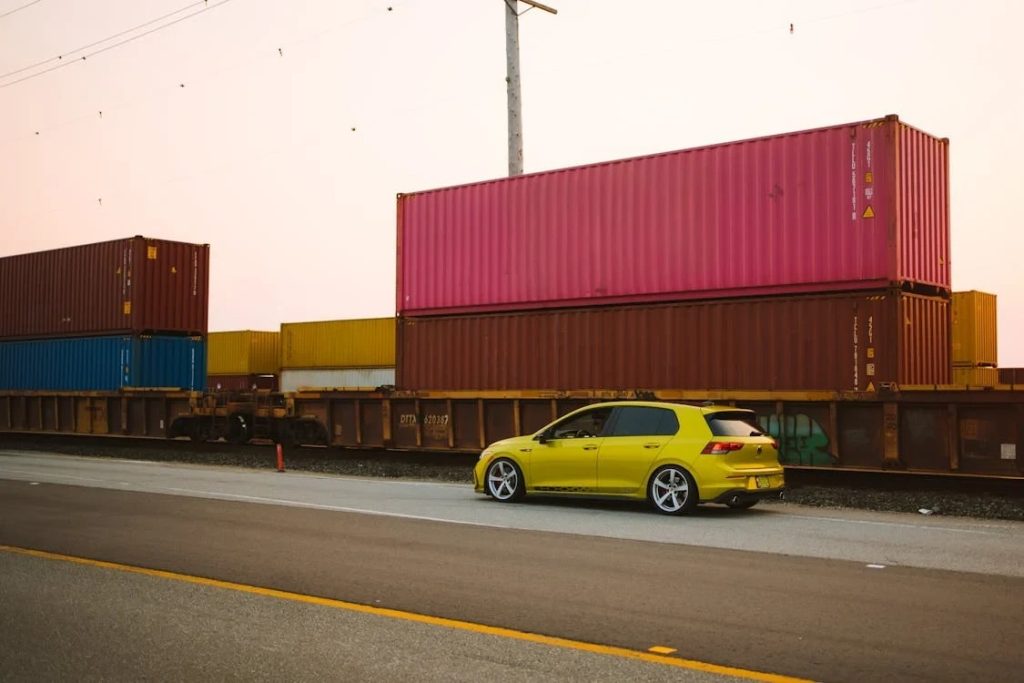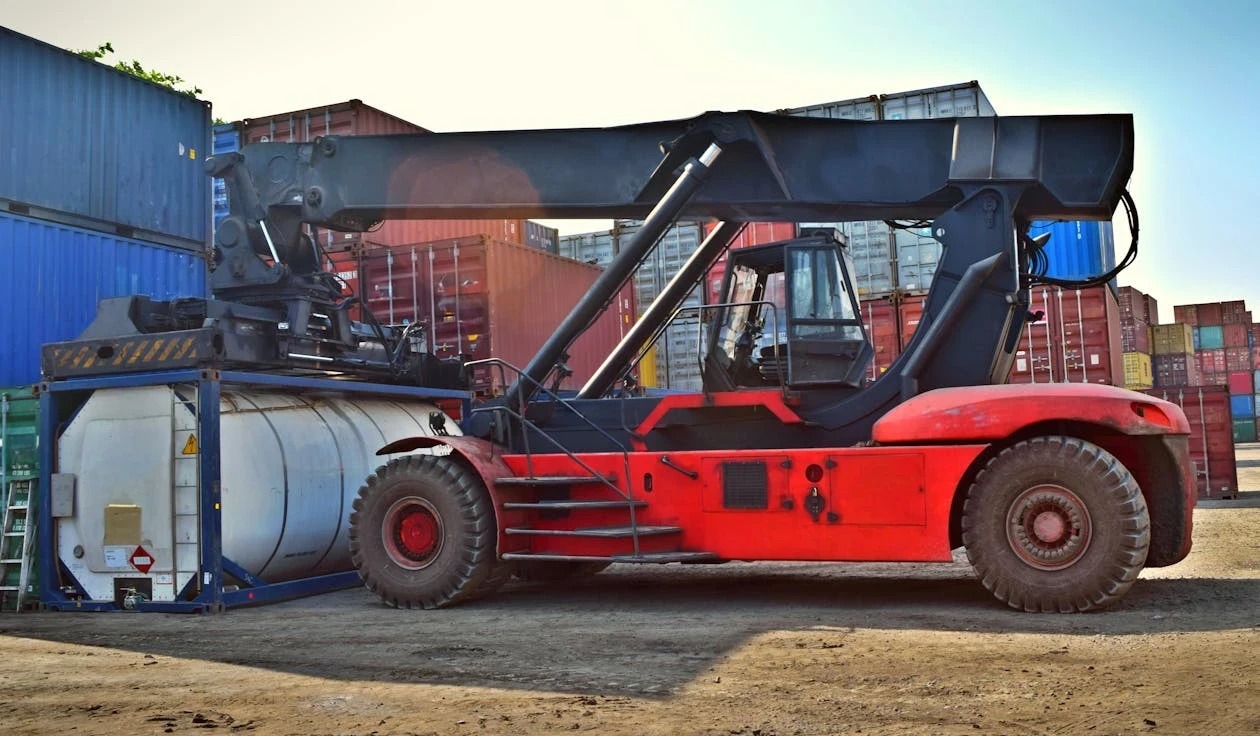As we know, tall containers, or high-cube shipping containers, have an extra height of one foot to make them capable of loading more cargo. However, there’s more to them than looking like unassuming steel boxes for transporting materials.
To transport high-cube containers safely and efficiently, you need the right tools and the appropriate platforms. In this opportunity, we’ll walk you through the best machinery and platforms to move tall containers during work!
Also Read: Choosing Between Truck vs. Train Shipping During Peak Season
Considerations Before Moving High-Cube Containers

Unfortunately, moving tall containers isn’t as simple as lifting and hauling them to a new location. You need to factor in these key considerations to keep the whole process smooth:
Weight and Load Distribution
20’ and 40’ high-cube containers can usually weigh between 4,800 and 7,700 pounds when empty. But, in their full capacity, they can exceed 30,000 pounds or more, depending on the cargo.
Because of that, proper weight distribution is important to ensure stability during lifting and transport. An unevenly loaded container can cause tipping, excessive strain on lifting equipment, and difficulties during transit.
Clearance and Road Restrictions
Since high-cube containers are taller than standard units, they need careful planning when you transport them. Many highways, bridges, and tunnels have height restrictions that could prevent safe passage.
For that reason, you need to check the permitted height limits for your route and plan accordingly.
Lifting and Loading Points
Shipping containers come with corner castings, which are standardized attachment points designed for lifting.
As such, use proper machinery like cranes, reach stackers, or forklifts with spreader bars to use these loading points effectively when moving containers.
Terrain and Site Conditions
If you’re placing a high-cube container in a construction site or remote area, consider the ground conditions.
Uneven surfaces, soft soil, or tight spaces may require specialized lifting equipment or additional support, such as gravel or concrete pads, to ensure stability.
Best Machinery to Move High-Cube Containers

Now, we know what to think of first before moving and transporting tall containers. Next up, let’s see the best platforms to move them during business operations!
Standard Cranes
Cranes are one of the most common tools for lifting high-cube containers. Various types, including mobile cranes, overhead cranes, and crawler cranes, are used depending on the location and lifting requirements.
Because of these varieties, ports, industrial sites, and large-scale warehouses often rely on cranes to handle containers efficiently.
Container-Lifting Jacks
If large cranes aren’t available, container-lifting jacks can become a cost-effective and portable solution. These hydraulic or manual jacks are placed at each corner of the container to lift it in stable condition.
While slower than cranes, they’re useful for small-scale operations, self-storage units, and remote work sites.
Forklifts
Heavy-duty forklifts with specialized container spreaders can handle tall containers in warehouses, logistics hubs, and container depots.
However, the forklift must have sufficient lifting capacity and have proper counterbalance to prevent tipping.
Gantry Cranes
Gantry cranes are large, overhead structures common in ports and intermodal terminals. If anything, it’s uncommon if ports don’t have one of these cranes.
They provide high lifting capacity and can move multiple containers quickly. For that reason, they’re essential for loading containers into ships, trains, and storage yards.
Reach Stackers
Reach stackers are versatile machines with telescopic booms that allow them to lift and stack containers up to five levels high.
They are ideal for shipping yards and intermodal terminals where quick and flexible container movement is indispensable.
Straddle Carriers
Straddle carriers lift containers by straddling them from above and allow for quick and efficient stacking in container yards.
These machines are self-propelled and can transport containers within ports and storage facilities without additional vehicles.
Truck Cranes
Truck-mounted cranes offer mobile lifting solutions ideal for construction sites, industrial areas, and on-site container placement.
Since they are truck-mounted, they can fulfill crane roles in places where full-sized crane isn’t feasible. Just bring a truck crane to the location, and move the container with no problem.
Top and Side Loaders
Top loaders lift containers from the top with a spreader attachment that makes them perfect for stacking containers.
Meanwhile, side loaders lift containers from the side and place them directly onto trailers. With this feature, they work perfectly for tight spaces and efficient transport.
Best Platforms to Move High-Cube Containers

At this point, the containers are ready for insertion and loading to their transportation modes for long-distance freight. So, what are the best platforms to transport containers in this situation?
Trucks
Trucking is the most common way to transport high-cube containers over land. Even so, trucks have many varieties that can meet the specifications of different business projects.
Here, choosing the right truck type depends on clearance requirements, route conditions, and loading needs.
Flatbed Truck
Firstly, we have flatbed trucks popular in construction, logistics, and freight transportation thanks to their versatility. Unlike enclosed trailers, flatbeds allow for easy loading of oversized cargo, including high-cube containers.
However, since flatbeds lack sidewalls or a roof, ensuring proper securing and strapping is crucial. Operators must use heavy-duty chains, ratchet straps, and twist locks to keep the container in place.
Step-deck Truck
A step-deck truck, also known as a drop-deck trailer, is designed specifically for taller cargo. The trailer has two deck levels – a higher front section, and a lower rear section that allows the container to sit closer to the ground.
This lower positioning can reduce height clearance issues so you can transport the container through areas with low bridges, tunnels, and overpasses. Furthermore, a step-deck truck can help avoid extra fees and logistical complications associated with height restrictions.
Tilt-bed Truck
A tilt-bed truck is one of the most convenient options for delivering and unloading high-cube containers. It comes with a hydraulic tilting mechanism that allows the trailer bed to angle downward and the container to slide off smoothly onto the ground.
Tilt-bed trucks have several advantages:
- No need for external lifting equipment
- Versatile placement options
- Quick unloading process
Trains

Rail transport is one of the most efficient and cost-effective methods for moving high-cube shipping containers over long distances. Trains provide a high-capacity, eco-friendly, and reliable solution for transporting containers across states, regions, and even international borders.
One key advantage is the ability to double-stack containers on specialized railcars, which maximizes space and reduces costs per container. By stacking two containers per railcar, logistics companies can transport more cargo at a lower fuel cost.
Cargo Ships

Last but not least, cargo ships are the go-to solution for moving high-cube containers across oceans and major waterways. Cargo ships maximize efficiency by stacking thousands of containers securely on board.
Operators secure the containers with twist locks and lashing rods to prevent movement during transit. Since high-cube containers are only one foot taller than standard containers, most modern cargo ships have no issues accommodating them within standard stacking configurations.
Additional Tips
- Check Clearance Limits: Always verify road, tunnel, and bridge height restrictions before moving high-cube containers.
- Secure the Load Properly: Use twist locks, straps, and chains to prevent shifting during transport.
- Use Escort Vehicles if Required: In some areas, escort vehicles may be necessary for oversized loads.
- Obtain Permits: Some regions require special permits for high-cube container transport.
- Plan for Unloading: Ensure proper lifting equipment is available at the destination.
Also Read: Moving Containers: Methods, Tips, and More
Conclusion
With proper moving and loading of tall containers, using them won’t differ that much from doing the same with standard-sized containers. To ensure nothing goes wrong with the process, only use high-quality high-cube containers from Tradecorp in your business projects. Contact us today to get yourself a 20′ or 40′ high-cube container to transport your cargo safely during freight!


